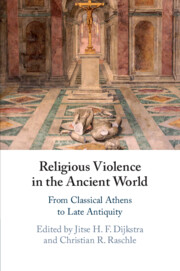Book contents
- Religious Violence in the Ancient World
- Religious Violence in the Ancient World
- Copyright page
- Contents
- Acknowledgements
- List of Contributors
- A Note on Abbreviations
- General Introduction
- Part I Methodology
- Part II Religious Violence in the Graeco-Roman World
- Part III Religious Violence in Late Antiquity
- Chapter 10 Religious Violence in Late Antiquity: Current Approaches, Trends and Issues
- Chapter 11 Coercion in Late Antiquity: A Brief Intellectual History
- Chapter 12 Crowd Behaviour and the Destruction of the Serapeum at Alexandria in 391/392 ce
- Chapter 13 Violence and Monks: From a Mystical Concept to an Intolerant Practice (Fourth to Fifth Century)
- Chapter 14 The Discipline of Domination: Asceticism, Violence and Monastic Curses in Theodoret’s Historia Religiosa
- Chapter 15 Suffering Saints: Shaping Narratives of Violence after Chalcedon
- Chapter 16 Fighting for Chalcedon: Vitalian’s Rebellion against Anastasius
- Chapter 17 The Emperor, the People and Urban Violence in the Fifth and Sixth Centuries
- Index of Sources
- General Index
Chapter 14 - The Discipline of Domination: Asceticism, Violence and Monastic Curses in Theodoret’s Historia Religiosa
from Part III - Religious Violence in Late Antiquity
Published online by Cambridge University Press: 18 September 2020
- Religious Violence in the Ancient World
- Religious Violence in the Ancient World
- Copyright page
- Contents
- Acknowledgements
- List of Contributors
- A Note on Abbreviations
- General Introduction
- Part I Methodology
- Part II Religious Violence in the Graeco-Roman World
- Part III Religious Violence in Late Antiquity
- Chapter 10 Religious Violence in Late Antiquity: Current Approaches, Trends and Issues
- Chapter 11 Coercion in Late Antiquity: A Brief Intellectual History
- Chapter 12 Crowd Behaviour and the Destruction of the Serapeum at Alexandria in 391/392 ce
- Chapter 13 Violence and Monks: From a Mystical Concept to an Intolerant Practice (Fourth to Fifth Century)
- Chapter 14 The Discipline of Domination: Asceticism, Violence and Monastic Curses in Theodoret’s Historia Religiosa
- Chapter 15 Suffering Saints: Shaping Narratives of Violence after Chalcedon
- Chapter 16 Fighting for Chalcedon: Vitalian’s Rebellion against Anastasius
- Chapter 17 The Emperor, the People and Urban Violence in the Fifth and Sixth Centuries
- Index of Sources
- General Index
Summary
The concept of asceticism is notoriously difficult to define, and we still cannot say that there is one ‘accepted’ definition. What we have are varying representations and propositions from ancient authors of the ascetic project, each with different emphases and goals in mind.1 Rather than straightjacketing an ancient author or literary work within a preconceived notion of asceticism, it should rather be asked how the author understands and utilises ascetic discourse and practice, and how this particular utilisation intersects with other related religious, cultural and political concepts and phenomena. One phenomenon with which asceticism has been shown to interact is that of violence. But the relationship between violence and ascetic discourse and practice has been shown to be quite complex.2 The notion that asceticism and acts of violence are not necessarily mutually exclusive has gained much ground in scholarly circles, and rightfully so.
- Type
- Chapter
- Information
- Religious Violence in the Ancient WorldFrom Classical Athens to Late Antiquity, pp. 323 - 344Publisher: Cambridge University PressPrint publication year: 2020



